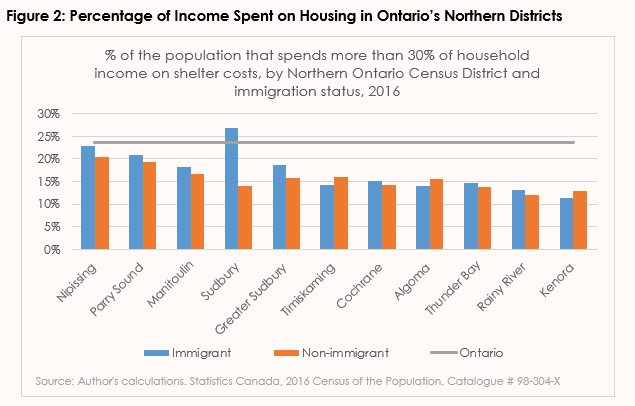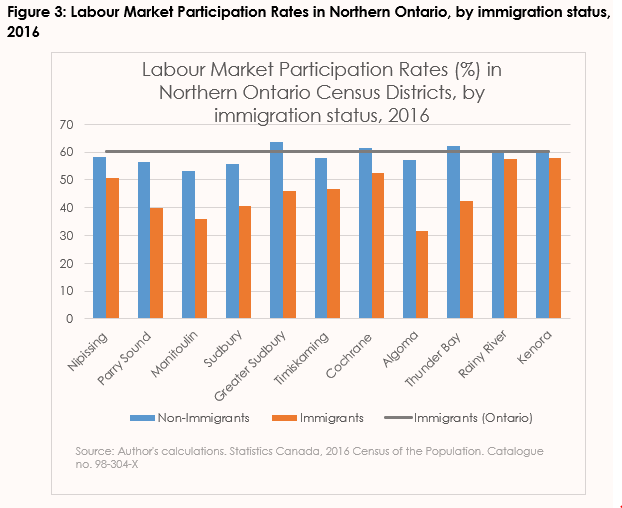Bonjour/Hi: How Welcoming are we to Newcomers? Part 1
September 22, 2020 - Ontario’s northern and western regions need immigration. Since 1976, seven out of 11 districts in Ontario’s western, northern, and central regions have faced a decline in population; all are experiencing a population shift. Demographically, the population is aging and youth are out-migrating in search of education and employment opportunities elsewhere. Thus, labour market shortages have, and will continue to, arise. Attracting and retaining immigrants is a crucial step in ensuring current levels of quality of life remain, despite demographic factors working against our favour.

Communities in Ontario’s northern, western, and central regions must deploy a “Welcoming Communities” strategy, whereas communities have agency and engage in actions that facilitate the integration of newcomers. Welcoming policy refocuses the efforts to integrate newcomers onto the host society, taking the burden partially off newcomers.
Municipalities and employers must take attraction and retention strategies into their own hands if they hope to attract migrants that typically locate in larger, more urban centres, such as Toronto, Montreal, and Vancouver. The rural and northern communities that need immigrants the most are receiving the least – why is that?
What is a Welcoming Community?
Immigration literature[i] and conversations with newcomers identify a few common indicators of a Welcoming Community, including suitable, affordable, and available housing, meaningful employment opportunities, and potential for social integration. This article will focus on housing and employment indicators; the follow-up article will discuss social integration and settlement services.
Housing
The Canada Mortgage and Housing Corporation (CMHC) defines “affordable housing” as costing less than 30 percent of before-tax household income. In eight out of 11 Northern Ontario districts, immigrants are more likely to spend over 30 percent of their household income on shelter costs, compared to the host population. The presence of significant portions of the population not having affordable housing points to the possibility that there is not enough housing available.[ii]
With the exception of Greater Sudbury, rent in Northern Ontario’s districts are cheaper than the Ontario average for bachelor, one-bedroom, two-bedroom, and three-bedroom dwellings. In addition, the median housing price is lower in all 11 district than the Ontario average. [iii] The lower housing costs could initially be what attract newcomers to Ontario’s Northern regions. Additionally, in all districts, the percentage of both immigrants and non-immigrants in unaffordable housing situations is lower than the Ontario average.

Beyond housing affordability, housing suitability means that there is housing available to fit the specific family size of the newcomer households. For example, newcomers typically migrate either as a family unit, or as a lone adult. Thus, housing needs are typically either one bedroom or three bedroom units. But, there are gaps in rental availability that particularly impact newcomers, though most were able to find adequate and suitable housing over time.
It is important to recognize these factors – housing, employment, social capital - work in conjunction to shape a welcoming community. For example, poor housing interferes with the organic process or developing social ties, creating adverse consequences for newcomers and existing communities alike.
Employment
The availability of meaningful employment opportunities are also cited as being a high priority for newcomers when choosing where to immigrate. Employment opportunities can be measured by looking at participation, employment, and unemployment rates. The quality of employment can be measured by looking at full-time versus part-time employment, as well as level of education compared to occupation and income.
High, or comparatively similar labour market participation rates between immigrants and non-immigrants can indicate the potential for labour market integration. But, participation rates are consistently lower among the immigrant population than the non-immigrant population across all 11 districts in northern and western Ontario regions. Additionally, participation rates are lower among immigrants in the 11 districts compared to the Ontario average for immigrants. Thus, if prioritizing participation in the labour market when choosing where to locate, newcomers might cross districts in Northern Ontario off their list.

The potential for employment and labour market participation is just the beginning. Newcomers want meaningful employment opportunities. One of the largest barriers to obtaining meaningful employment is employers incorrectly evaluating foreign credentials and not recognizing non-Canadian work experience. Without validation of previous experience and education, newcomers face the risk of being underemployed. Underemployment occurs when a person’s occupation is not making full use of their skills and abilities, or a part-time worker would prefer to be working full-time.
Underemployment can lead to higher job dissatisfaction, having negative repercussions on social integration and family outcomes.[i] Statistics Canada found that newcomers with higher levels of educational attainment often had more negative perceptions of their quality of life, since there was a disconnect between their economic reality and their expectations, largely due to foreign credential recognition.
How to Increase Welcomeness
In a 2018, NPI report, Christina Zefi estimates that by the year 2036, most Northern Ontario districts will face a high ratio of dependents to working people. Newcomers fill essential gaps in the communities they choose to settle in. In fact, studies suggest that migrants tend to reduce the non-working-age dependency ratio, are typically younger than the destination population, and increase investment in the region in which they settle.
Attracting newcomers is half the battle, retaining them is the other. Moving forward, it will be key for employers and communities to enhance their welcome of immigrants to their regions and to consider ways to retain them once they settle.
Ontario’s Northern regions are not forever destined to labour market shortages caused in part by high levels of out-migration, under-integration of the host population, low immigration levels, and an aging population. The regions must work to market their attractive features, such as comparatively low housing costs, and improve on its shortfalls. With a Welcoming Communities strategy, districts can welcome, attract, and retain newcomers, benefiting members of the communities at large and for years to come.
[i] Esses, Victora, Leah Hamilton, Caroline Bennett-AbuAyyash, and Meyer Burstein. 2010. “Characteristics of a Welcoming Community.” Citizenship and Immigration Canada. (17).
[i] Painter, Carla Valle. 2013. “Sense of belonging. Literature review.” Citizenship and Immigration Canada. Available online at https://pdfs.semanticscholar.org/4436/29b65883ce76694f9424c8001db003b9a11a.pdf.
[ii] Bevilacqua, Jessica. Upcoming. “House Hunting: Northern Ontario Edition.” Northern Policy Institute.
[iii] Bevilacqua, Jessica. Upcoming. “House Hunting: Northern Ontario Edition.” Northern Policy Institute.
Write for us
Mercedes Labelle is a Research Analyst at NPI
Thank you to our Experience North Sponsor 
The content of Northern Policy Institute’s blog is for general information and use. The views expressed in this blog are those of the author and do not necessarily reflect the opinions of Northern Policy Institute, its Board of Directors or its supporters. The authors take full responsibility for the accuracy and completeness of their respective blog posts. Northern Policy Institute will not be liable for any errors or omissions in this information, nor will Northern Policy Institute be liable for any detriment caused from the display or use of this information. Any links to other websites do not imply endorsement, nor is Northern Policy Institute responsible for the content of the linked websites.
Northern Policy Institute welcomes your feedback and comments. Please keep comments to under 500 words. Any submission that uses profane, derogatory, hateful, or threatening language will not be posted. Please keep your comments on topic and relevant to the subject matter presented in the blog. If you are presenting a rebuttal or counter-argument, please provide your evidence and sources. Northern Policy Institute reserves the right to deny any comments or feedback submitted to www.northernpolicy.ca that do not adhere to these guidelines.
